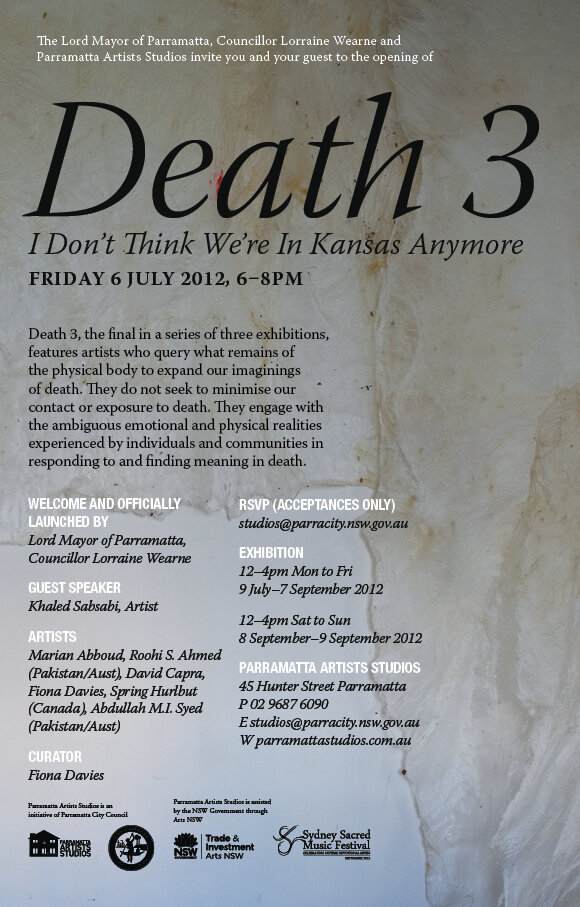Curatorial Projects.
Carnivale Catastrophe presented by MAPBM for Cementa 22 in Kandos NSW Australia 2022
A knock on the door.
You have to leave now.
We need to go. We’ve got 20 minutes.
Need to pack now.
Can't breathe/can’t get across the river/ can’t see for the red dust/ can’t see through the smoke and flames.
Fabrik presented by MAPBM at Penrith Regional Gallery Home of the Lewers Bequest, Emu Plains Sydney Australia 2020/2021
The exhibition conceived and implemented by MAPBM was titled Fabrik. The title of this exhibition, overlays the word fabric, the basis of all textile and clothing, with the word fabrik to emphasise the place of making, of manufacture rather than just the material being made. The five artists, Vivienne Dadour, Beata Geyer, Anne Graham, Ian Milliss and Ebony Secombe are members of Modern Art Projects Blue Mountains (MAPBM) which is based in the Blue Mountains and Western Sydney. MAPBM is a membership-based group which seeks to develop the practice and public presentation of contemporary art in this region and this context.
The idea that the object is not independent of how it is made, how it is used and how it is disposed of is the basis of this exhibition. By looking at one element of our lives - how we buy and wear clothes and buy and use textiles in our homes - we can consider so many other aspects linked to us through these everyday activities. We can think about conditions of employment, how we use, reuse and dispose of the materials in our world, how our history informs our present and how change can be sought..
Very extensive talk given by the art historian and critic Elin Howe to coincide with the exhibition SewnUp .
SEWNUP presented by MAPBM at Lyttleton Stores, Lawson, Australia 2020
SEWNUP 1 and 2 presented by e MAPBM exhibitions, a Blue Mountains contemporary arts group questioned fundamental aspects of how we manufacture, use and dispose of clothing, footwear and textiles. SEWNUP I opened on the 4th April 2020. It then reopened in October 2020 after Covid-19 lockdown conditions had been eased. In the comfortable and familiar surroundings of the popular cooperative store and gallery the artists examined the materiality of sewn consumer goods and some of the questionable aspects of their manufacture and disposal, including the economic security and conditions of workers in these industries. SEWNUP also explored the feasibility of reusing or repurposing textiles, clothing and footwear – as well as the major ecological impacts of their disposal to landfill. The public was invited to examine the delight of these consumer goods, but also to become more aware of their downside. SEWNUP occupied the space between the beauty and appeal of textiles. clothing and footwear and the impacts of their production and disposal on the social and ecological fabric of society.
This project was supported by the Blue Mountains City of the Arts Trust
Op Shop, Maitland Regional Art Gallery MRAG, Maitland NSW Australia 2013
I was asked to curate the last all gallery exhibition to celebrate the long tenure of the Gallery director Joe Eisenberg. Joe asked me to combine my interests in oral history, using multiple of domestic objects as art materials and the practice of op shopping as looking for the randomly gorgeous, as a key part of my art practice. I selected a number of other artists who also used these practices.
Death 3 I don’t think we’re in Kansas anymore exhibition at Parramatta Artists Studios, Parramatta, Sydney Australia 2013
Death 3, I don’t Think we’re in Kansas Anymore was the third and final exhibition at Parramatta Artist Studios in this series thinking about death. As Ann Finnegan wrote in her catalogue essay; ‘This, the final exhibition of a trilogy… startles with its premise of ‘relationships with a body, the body of the deceased. the very work relationship conjures closeness, intimacy, live negotiations entered into, engagements of live bodies among the land of the living. Indeed the work relationships enters into a certain ongoing-ness. Therefore it’s strange , even arresting to think of a relationship with the dead body. ‘A body was found.. we indicate a corpse. Consort with the dead, you breach a taboo. For what is the body, the body found dead but a kind of material remainder, in Derrida’s terms’ a leftover’, the rest, the spirit departed. A body, ‘ a body was found’. is something abject, tinged with horror, requiring disposal, separation. ’




